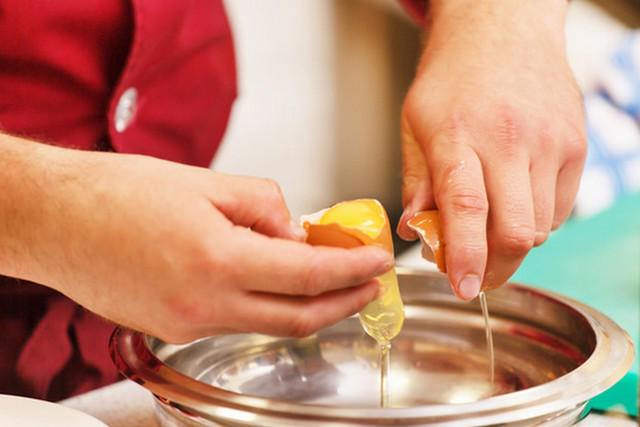How to make cloudy broth clear. Clarifying broth for jellied fish.
How to clarify the broth if we are preparing aspic or jellied meat? The process of clarifying the broth is called pulling. To begin with, it should be strained through several layers of gauze placed in a colander. At this stage he is freed from excess fat, foam and small particles. To do this, use raw egg whites, minced meat and ice water. For two liters of broth, it is enough to take one protein.
Combine: 100 g minced meat 1 protein 3 tbsp. spoons of ice water
The result is an absorbent that will collect everything unnecessary from the broth. Pour it in a thin stream into the hot, but not boiling broth, constantly stirring it with a spoon. Boil for 5 minutes, continuing to stir, and remove from heat. Cool the broth and strain.
Helpful advice: cook the broths over low heat, then they will turn out less cloudy and retain maximum nutrients. Skim off any foam while cooking the broth.
Here are a few simple rules proper cooking of meat, adhering to which, you can achieve excellent results in its preparation. How to cook meat correctly
Cooking meat for broth. So, if you need to cook broth, then put the meat only in cold water. This way we can transfer from meat to broth maximum amount nutrients. After the pan with the broth boils, cover it with a lid and cook over low heat, without opening the lid until the cooking is finished. We do not remove the foam that forms during cooking of the broth, as it is a very healthy protein. After the meat is cooked and the broth is ready, let the meat stand in the broth for 10 minutes, after which you can take it out.
If we're cooking meat for the second, then we put the meat in boiling water so that all the nutrients, on the contrary, remain in the meat. How long to cook meat
- Beef cooking time. A piece of beef up to 1 kg should be cooked for about an hour to an hour and a half after the water boils. If the beef was previously frozen, then cook it for at least one and a half hours.
- Pork cooking time. Pork should be cooked for 1.5 - 2 hours after the water boils.
- Lamb cooking time. Lamb is usually cooked for one and a half to two hours.
- Chicken cooking time. For chicken meat to be fully cooked, it is enough to boil for 40–50 minutes. If it is broiler chicken, then cook it for an hour and a half.
- Duck cooking time. A whole duck is cooked for an hour and a half, and a duck cut into pieces takes up to 40 minutes.
- Goose cooking time. Goose takes much longer to cook than duck, even when cut into pieces, up to three hours.
- Cooking time for rabbit meat. The rabbit should also be cooked for one and a half to two hours. If the rabbit is not whole, but in pieces, then only 40 minutes will be enough.
How long to cook meat for jellied meat. If you want to cook jellied meat, you need to cook the meat for up to 6 hours. If the meat is good and slides down the bone on its own, then you can stop cooking the jellied meat.
Bon appetit!
Today we’ll look at what a guy is.
Drawing is a technique used in cooking to clarify liquids: broths, juices, syrups, jelly solutions for aspics, etc. This is a rather complex process. Appearance the soup can be made worse if you don’t know the rules of pulling.
The guy can be made from beaten egg whites, which are introduced into the appropriate liquid and heated with it, absorbing all the impurities present there. Then the guy along with the foam is removed and thrown away. Protein extract is used in all non-meat dishes.
In meat dishes, raw minced meat made from lean meat (low-fat) is used as a brace. The meat strip can then be used as a filling, that is, unlike protein, it can be re-used culinaryly.
To clarify broth that has become cloudy during cooking, a mixture of minced meat, cold water and egg white is most often used.
The pull can be done with meat, fish, and chicken broths. Each of them has its own recipe. One way or another, all methods of clarifying broths are based on the unique properties of egg white to “pull out” the smallest particles, which actually create turbidity. Lightening occurs due to thermal contrast, when the protein extract is introduced cold into the hot broth.
This is where the verb “delay” came from - to lighten.
In addition to proteins, texture additives (raw minced meat, crushed bones, eggshells, grated raw carrots) can be added to the pull-off composition, which further enhances the lightening effect.
Types of guy lines
In cooking, there are the following types of guys:
- draw for meat broths- 100 g raw grated carrots and 1 egg white;
- drawbar for bone and meat-bone broths- 200 g minced meat and egg white;
- chicken broth pull- eggshell and 1 egg white;
- pull for chicken and turkey broths- 20 g of crushed chicken bones or minced chicken without skin and 1 egg white;
- O drawstring for chicken and fish broths, broth for aspic- 2-3 egg whites.
How to clarify broth using a pull-off
First you need to prepare one of the types of guy by simply mixing all the ingredients, whisking a little and cooling the mixture in the refrigerator. The guy must be very cold.
The broth temperature should be approximately 60-70 degrees. First add half of the cold guy, stir, quickly bring to a boil, then pour in the remaining guy, stir, bring to a boil again. Then reduce the heat and cook the broth exactly until the pull together with the dregs forms a cake on the surface of the broth.
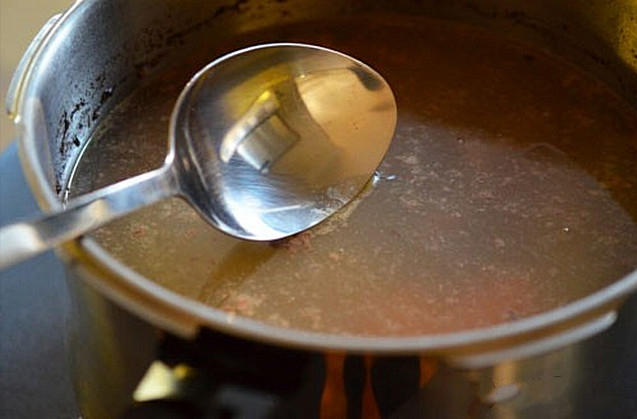
For example, with ground beef this will happen in about an hour, and with protein - in 5-10 minutes.
After the specified time, remove the pan from the heat and leave for some time. After cooling, the pull-out cake is removed from the surface with a slotted spoon, and the clarified broth is filtered into a clean pan.
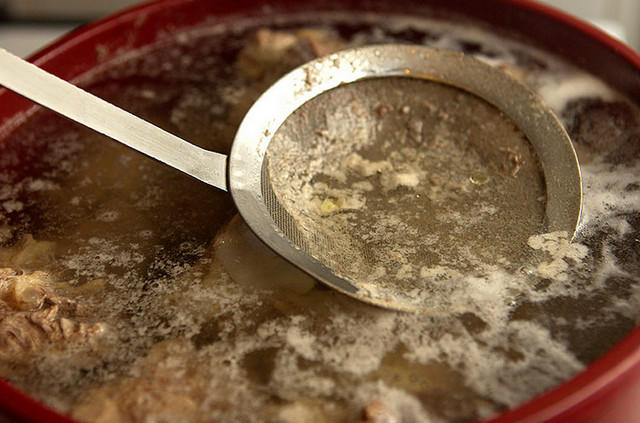
Thus, the clarification process is:
- firstly, in choosing the composition of the draw that is suitable for a given broth, preparing it and cooling it;
- secondly, by introducing the guy into the hot broth in two stages with stirring, boiling and cooking until a thick layer forms on the surface;
- thirdly, in infusing the broth, removing the cake and straining.
***
Despite the above, for meat broths Pull - this is most often beaten egg whites, which are diluted with water and, with constant stirring, are poured into the broth, heated together with it, absorbing unnecessary impurities. Then the broth is filtered.
More for meat broth do this stretch:
meat for clarification is taken at the rate of 1/5 of the total amount of meat products. For every 200 g of meat you need 1 protein and 230 ml of cold water. The meat should not be fatty.
What to do: the meat should be passed through a meat grinder twice or finely chopped with a knife, add 3 egg whites, 700 ml of cold water, mix until smooth and puree and put in the refrigerator.
Remove meat and vegetables from the finished broth (strain).
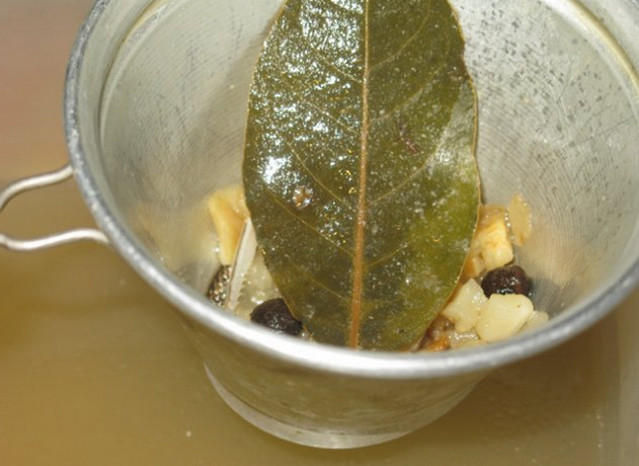
Pour 5-6 tablespoons of hot broth into the draw, stir and quickly pour into the broth. Stir, cover loosely and cook over very low heat for 30 minutes.
The cooked brad will curl into a dense thick layer on the surface of the broth.
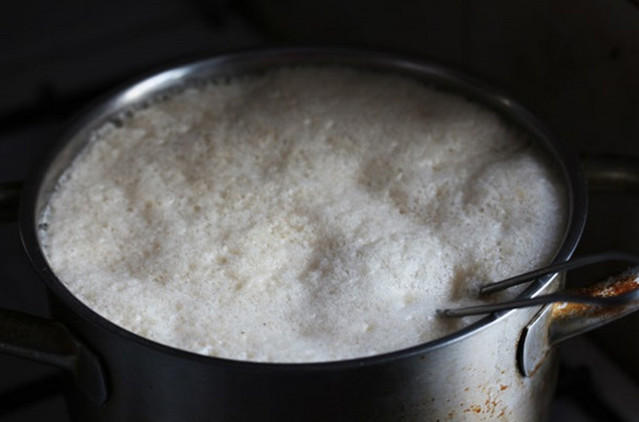
Carefully remove the resulting mass, and strain the broth, trying not to shake it - take it in portions with a ladle. Boil again.
![]()
Now the entire clarification process is complete, the broth should be absolutely transparent, rich and aromatic.
And now, girls and boys, as they say - feel the difference!

For poultry broth the guy can be prepared from neck and shank meat. It is passed through a meat grinder and poured cold water(1.5 - 2 parts water to 1 part minced meat) and place in a cold place.
After 1-2 hours, add the beaten egg whites and salt, mix, pour into the broth, bring to a boil, remove the fat and any foam that has formed, and then cook over low heat for an hour and a half.
You need to let it sit, remove unnecessary fat and strain. However, for chicken broths you can get by with a regular protein extract.

For fish broths The whites are mixed with water in a ratio of 1:5, coarsely grated carrots and onions are added, added to the warm broth, brought to a boil, and kept at a low simmer for 20-30 minutes. The guy should settle to the bottom of the pan. All that remains is to strain the broth.
The role of a guy for fish broths can be performed by pike and pike perch caviar, ground with a small amount of water until a homogeneous mass is obtained.
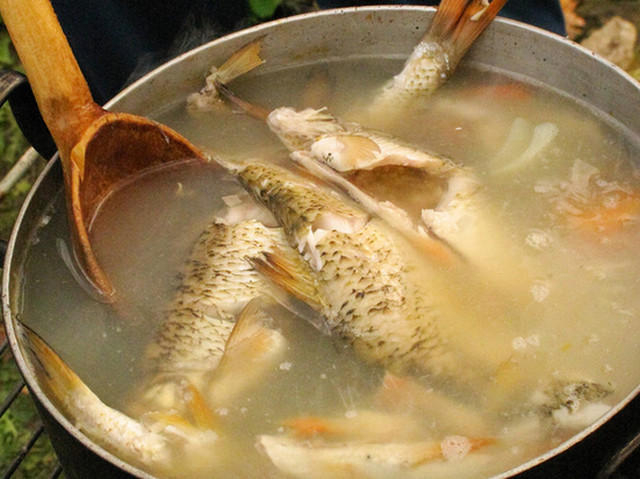
Actually, I think that how to make a guy for broths is already more or less clear. However (just in case: o) I will give a couple of more detailed recipes.
Transparent meat broth with draw
Ingredients
- 500 g 1st grade beef,
- 1 carrot,
- parsley or celery root,
- 1 onion,
- 1.5-2 liters of water,
- salt to taste
For guy
- 300 g raw meat without fat,
- 1 egg (white)
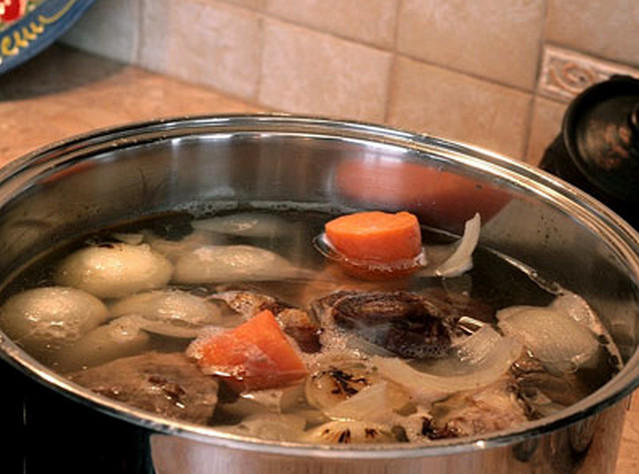
Cooking method
Rinse the meat and place in a saucepan, add cold water, cover with a lid and put on fire. Bring to a boil, reduce heat and skim off foam. Cook for 1-1.5 hours, then put half of the peeled and coarsely chopped onions and roots into the pan, chop the other half and fry on one side in a frying pan without oil, then also put it in the broth and salt it. Fried roots will give the broth a beautiful golden color.
Adviсe
- The broth should be filtered through a damp linen napkin, which is washed without soap. To keep the napkin perfectly clean, you need to thoroughly boil it in water with the addition of baking soda.
- The total duration of cooking the broth is 2-2.5 hours. The finished meat should be removed from the broth and used for second courses. Let the broth settle, remove fat from its surface and strain through a fine sieve or napkin.

To make the broth more concentrated and completely transparent, you need to pull it off (clarify).
To strain, pass raw meat through a meat grinder, place the minced meat in a separate bowl, add egg white and 200 ml of broth and leave for 20-30 minutes, then pour this mixture into the pan with the broth.
Cover with a lid, put on low heat and cook for another 30-40 minutes. After the guy curls up and sinks to the bottom, carefully strain the broth.
If the broth is made from chicken, the guy is made from chicken meat, to clarify the broth from game, game meat is taken. Transparent meat broth is served with croutons, pies, corn flakes and other side dishes.

***
Ingredients
- 400 g beef (preferably the flesh of the hind leg),
- 1 onion,
- 1 carrot,
- 1 leek stalk,
- 2 cloves of garlic,
- 1 parsley root,
- 1 tbsp. l. ghee,
- 2 liters of water, salt to taste

Cooking method
Cut the meat from the bones, rinse thoroughly and cut into small pieces (weighing approximately 50 g). Chop the bones into small pieces, place on a baking sheet and place in the oven to bake. Stir occasionally to ensure the bones cook evenly. Onion peel, cut into circles and fry in heated ghee until golden brown. Peel and finely chop all other vegetables.
When the bones turn brownish in the oven, place them in a saucepan, add meat and vegetables, and add salt. Place the pan on the fire, bring the water to a boil, reduce the heat and skim off the foam. Cook over low heat until the meat is completely cooked. Then turn off the heat, remove the meat from the pan, and strain the broth.

P.S. And finally...
1. In order for the lightening effect to fully manifest itself, you should not skimp on proteins.
2. Clarification using minced meat gives an excellent result, because the broth, in addition to transparency, acquires additional flavor, aromatic and nutritional substances from the minced meat.
3. To prevent the broth from lightening, it is necessary not to allow rapid boiling during cooking, carefully skim off the foam, and do not add water, especially cold water.
Follow all the recommendations for cooking the broth, and you will be provided with transparency on its own. But if you are unlucky, don’t worry - just make changes to the menu, cook a thick soup, and then the cloudiness of the appetizing broth will not be noticeable.
Based on materials
Cited
Liked: 9 users
Aspic tongue is an excellent cold appetizer.
To prepare aspic
languages you will need:
- tongue (beef, veal) - 1 pc.
- onion - 1 pc.
- carrots - 1 pc.
- egg - 2 pcs.
- peppercorns
- Bay leaf
- fresh cucumber and parsley (for garnish)
Calorie content of products (kcal per 100 g):
language - 146;
onion - 43;
egg 1 pc. - 79;
carrots - 34;
cucumber - 11;
parsley - 49;
Method for preparing jellied tongue
- Rinse the tongue, put it in a saucepan, add cold water and cook for 2 - 2.5 hours. After boiling, add salt and remove noise. 1-1.5 hours before readiness, add onion, carrots, pepper. 5 minutes before readiness, throw in the bay leaf. After cooking, remove fat from the surface.
- Place the boiled tongue in cold water for a few minutes (it will be easier to remove the skin). We begin to remove the skin from the thin end. Place the cleaned tongue in the broth in which it was boiled and cool.
- Cut the cooled tongue into thin pieces or cubes.
- Place in a dish and garnish with slices of hard-boiled egg, carrots, fresh cucumber, parsley leaves.
- Carefully, so that the decoration does not move, pour in specially prepared clarified jelly.
Jelly can be made from the broth in which the tongue was boiled. You can also use low-fat beef, pork or chicken broth to make jelly. How to prepare jelly for filling is described below.
Method for clarifying the broth:
- Beat 1 raw egg white in a bowl.
- Pour in a glass of cold broth.
- Add a teaspoon of vinegar or lemon juice.
- Mix everything and pour into the boiling broth.
- Bring to a boil, remove from heat.
- After 15-20 minutes, strain carefully without shaking.
Method for preparing jelly:
- Gelatin for about 40 minutes. soak in a small amount of cold broth, in a ratio of 1:5 (1 g gelatin - 5 g broth).
- Bring the broth for pouring to a boil, simmer over low heat for 3-5 minutes, then add pre-soaked gelatin to the broth.
- Stir until completely dissolved, bring to a boil (but do not boil) and remove from heat. You cannot boil broth with gelatin, as the gelling properties of gelatin will deteriorate.
An important point is the clarification of broths. Clarification, of course, is very restaurant style, but sometimes at home you need to correct the broth, namely, clarify it. Clarification of broths is based on the ability of proteins to coagulate, trapping particles that form turbidity. Therefore, bleaching mixtures must be high in protein. In pre-revolutionary Russia, it was customary to clarify broths, scary to say, with black caviar! An ordinary clarifying mixture (called “pull”) is minced meat combined with cold water and raw egg whites. They do this - add a mixture of minced meat, water and raw egg whites to a cloudy broth (ideally cold and low-fat - read about low-fat broth), mix and heat, stirring gently from time to time so that the clarifying mass does not settle to the bottom. When the particles of the clarifying mass begin to float upward, mixing stops. Heating is slightly below average. Over time, a crust of coagulated lightening mass forms on the surface of the broth. Underneath is clarified broth. The process is not finished yet - you need to make a hole in the middle of the crust so that the broth “bubbles” through it to the surface and is additionally filtered through the clarified mass. This is also desirable because the taste of the broth, when filtered, is additionally enriched with the taste of minced meat (but the minced meat still needs to be cooked). In many cookbooks they write that the crust eventually falls to the bottom of the pan and this indicates the end of the clarification process. (I am sure that the authors of those books never clarified the broth, nor do they have any idea about the preparation of other dishes described in their books.) When the crust of the clarifying mass has cooked a little, the pan should be removed from the heat and, pressing the ladle on the hole in the middle of the crust, select the clarified broth and strain it through cheesecloth. The curled “guy” should not be removed.
This is how they prepare the main consommé - a type of soup that is clear broth with any fillings: slices of vegetables, rice, quenelles, etc. Madeira is often added to the consomme (when the consomme is heated) - this improves the taste.
I note that you can lighten the broth with less “blood”, namely a mixture of grated onion and raw egg whites. The sequence of actions is the same.
As for defatting the broth during cooking, we have already covered this, but it is impossible to completely remove fat during cooking. If you want to remove the fat completely, then remove the broth from the heat, wait until the fat collects on the surface and remove it using the same spoon, and then, using a white paper napkin, throw the napkin over the surface of the broth and quickly remove it. The mechanism is clear - droplets of fat are absorbed into the napkin. If you do this several times, the broth will be perfectly fat-free. When you have time, you can not transfer the napkins, but simply cool the broth, then the fat on the surface will turn into a crust, it is easy to remove.
Now about spices in relation to broths. If the broth is intended for the subsequent preparation of some kind of characteristic (with emphasis on the second syllable), pronounced soup - borscht, cabbage soup, pickle, solyanka, spices should not be added to the broth; we will add them while cooking the soup itself. If we are faced with the task of preparing, for example, a broth with noodles, dumplings, in general, something out of character (with the emphasis on the same syllable!), then about 20 minutes before the end of cooking the broth, add a bay leaf at the rate of about 1 PC. per liter of liquid, a few black peppercorns per liter, a couple of cloves. By the way, cloves can be added to the broth at the beginning of cooking. To do this, it is stuck into an onion, which is not fried. This is, of course, very French.
So, we looked at the important aspects of preparing broths using beef as an example. However, you can't ignore chicken broth. The chicken should also be soaked in cold water, add fresh water, quickly bring almost to a boil, rinse and cook further in new water. Vegetables: onions, carrots or celery. Vegetables can be baked; you should not remove them during cooking - they will become a sponge around the time the broth is ready, so you can forget about this advice when it comes to chicken. It hardly makes sense to flavor chicken broth with bay leaves and cloves.
Particularly zealous housewives can adopt this technique - removed during cooking chicken broth fat can be used for frying (you can also use beef fat, but it is still heavy). But this fat should, as chefs say, be cut off. After all, when skimming fat from the broth, we also grab part of the liquid with a spoon; it is not needed for frying, so this liquid should be “forcibly” evaporated, that is, carefully heat the skimmed fat, the water will gradually evaporate and pure fat will remain, after hardening it is successfully stored in refrigerator.
Pork broth is also prepared, the cooking rules are similar to those for beef, the fat can be collected, colored and used. But I prefer to cook broth from fried pork. This broth is in some way a by-product of cooking boiled pork. I prepare boiled pork neck meat according to a special recipe: I stuff the neck with garlic (here’s another trick for you - I take large cloves of garlic, peel, cut lengthwise and bread the cut - it’s moist! - in a mixture of salt and ground pepper, after that I stuff it - in In this case, the salt and pepper penetrate into the meat!), then I fry it heavily, transfer it to a saucepan, pour boiling water over it and cook until tender, skimming the fat from the broth. Vegetables are not needed, but bay leaves and peppers are. The meat was cooled - excellent boiled pork, and the resulting broth for borscht or pea soup– you can’t imagine anything better!
As for fish broths, it is important not to cook them for a long time. Usually the broth is made from the heads, ridges, and fins of fish. (The gills must be removed, although the popular belief that they add bitterness to the broth is wrong - I deliberately tried to cook the broth from the heads of different fish without removing the gills - nothing bad happened. One smart guy once wrote this, and all the others picked up , without checking. For aesthetic reasons, it is worth removing the gills, but not because of potential bitterness.)
Let's go back to the cooking time: no more than 20 minutes of low simmering after a quick boil. There is no need to bake the onion; you can simply add it after the first removal of the foam. You can add carrots, but I personally don’t add them. It's good to add a small piece of fennel. Fat needs to be removed. Black pepper - yes, bay leaf - no (I emphasize: we are making broth, not fish soup!).
Dry mushroom broth is cooked without vegetables and spices. It is important to soak the mushrooms in cold water for a while - foreign particles (sand, earth) will get wet and sink to the bottom. Then remove the mushrooms from the container and rinse. The water in which the mushrooms were soaked must be filtered through cheesecloth into a saucepan where the broth will be cooked, add the mushrooms and cook. It should be borne in mind that dry mushrooms are a very aromatic product (but not cheap), so it is important not to overdo it with the amount of mushrooms. If you make a mistake, don’t be alarmed; very concentrated mushroom broth can always be diluted with water.
A little about storing broths - they spoil quite quickly even in the refrigerator. Therefore, the broth must be brought to a boil from time to time and boiled for at least 2 minutes. Or just freeze it. On occasion, I pour the broth into a washed juice bag, write a note on the bag about the contents and put it in the freezer compartment. Freezing does not affect the quality of the broth.
To sum it up:
Beef, chicken, raw pork should be soaked, poured with cold water, quickly brought almost to a boil and rinsed, then, poured with water again, boiled.
Always boil quickly, remove foam and cook slowly.
Skim off fat during cooking.
While cooking broths, you can add water, but only boiling water.
A bunch of greens can be added when cooking broth, but only for uncharacteristic soups.
Remove vegetables in time.
It is not necessary to salt the broths, but if you do, it should be done about half an hour before the end of cooking.
Spices - shortly before the end of cooking.
Many housewives are concerned with the question: how to lighten the broth? A cloudy brew will take away the appetite of your household, because the finished dish looks unappetizing. Take care of the transparency of the broth while cooking it and use our tips. Both meat and fish broths can be clarified.
How to clarify broth - why does it become cloudy?
Improper cooking of the broth leads to its cloudiness, namely:
- you pour food ingredients for soup hot water. This cannot be done. First, fill the meat in a saucepan with cool water, and then place the broth on the stove to cook;
- you do not skim the foam at high boils. Remove foam and fat in a timely manner after boiling water with meat in a pan;
- you do not use vegetables to cook the broth. Be sure to cook the dish with vegetables. To make the broth clear, place a peeled onion in the pan;
- you don't strain the broth after cooking. Strain it through cheesecloth or a fine sieve. This will help remove foam, small meat bones and lighten the broth. Then pour the brew back into the pan and prepare soup or borscht.
How to clarify broth during cooking
You will get a clear broth if the purification process takes place in several stages:
- turn down the heat on the stove after the broth boils;
- cook over low heat, periodically remove the foam with a slotted spoon or a large regular spoon. This will take 1-1.5 hours;
- Before finishing cooking, remove large pieces of meat from the pan;
- pour 3-4 tbsp into the pan with the brew. spoons of ice water.
Boil for another five minutes over low heat. If the broth does not bubble too much in the pan, it will turn out more or less transparent. But you still need to strain it through a sieve or several layers of gauze and pour it into the pan again. You will receive a clear broth, ideal for preparing first courses.

How to clarify finished broth
You have a ready-made cloudy broth, and even after straining its quality leaves much to be desired. Don't worry, this can be fixed. Use one of the lightening methods:
- roasted carrots and onions. Fry the vegetables, you can add minced meat and place them in the boiling soup. Cook until the soup turns light;
- gauze bag with rice. Make a small bag out of gauze and put the uncooked rice in it. Place the bag in a boiling dish and boil for up to 10 minutes;
- whipped a raw egg. Beat the egg and pour into the boiling broth;
- carrot. Cut the peeled carrots into two parts. Fry it a little without oil in a frying pan and add to the broth before finishing cooking;
- grated cheese. Grate the cheese on a coarse grater. Add it gradually to the soup, stirring constantly.
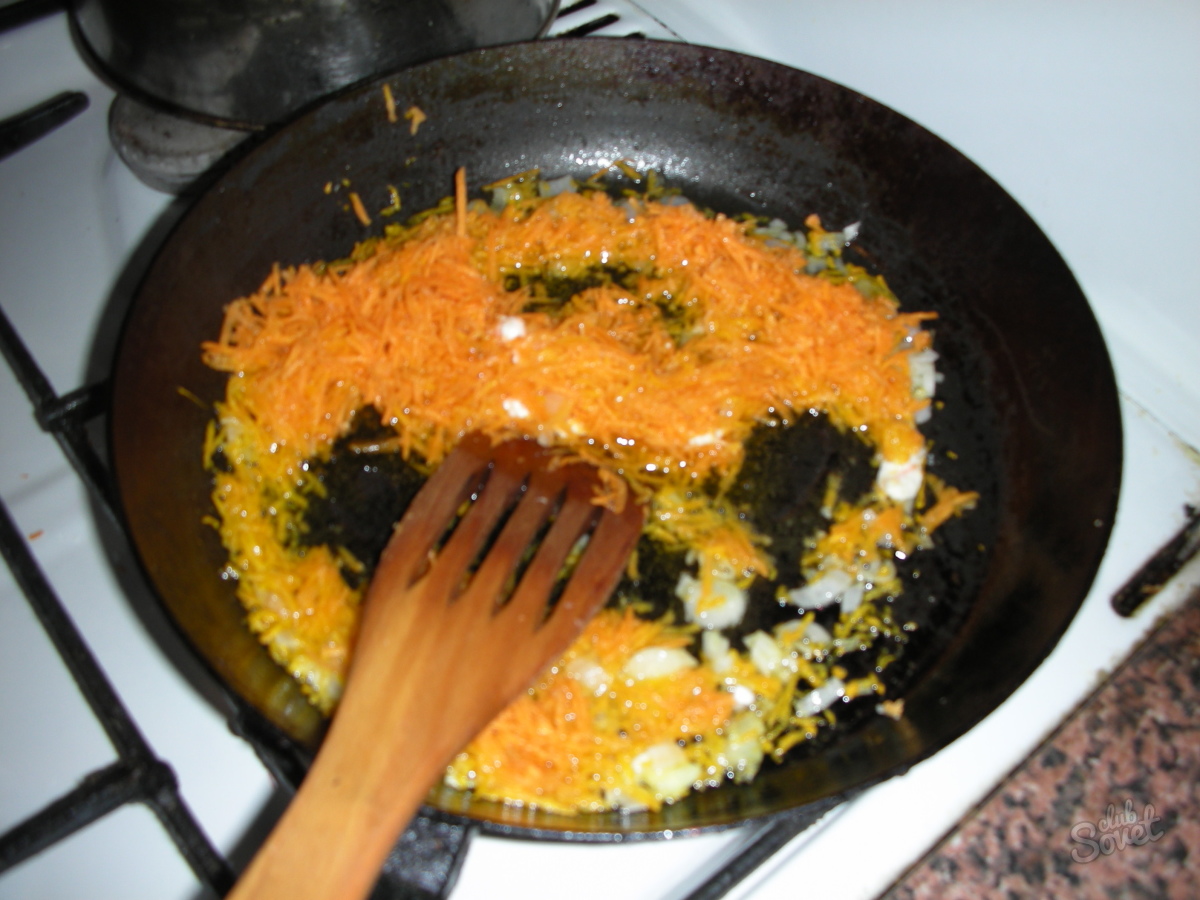
How to clarify fish broth
All of the above clarification methods apply to meat broths. But often the fish broth becomes cloudy. There are ways to fix this situation:
- crush 5 pieces of ice from the freezer. Add the beaten egg white to the crushed ice and stir. Place this mixture into the broth and bring to a boil. Immediately turn off the stove and leave the brew to brew for 10 minutes. Then remove the foam;
- Use an absorbent made from egg whites and shells. It will create large clumps, you will remove them and the broth will become light. For 3 liters of liquid, take 2 whites and the shells of two eggs. Cool the finished broth to 70 degrees. Combine the beaten egg whites with the shells and add to the pan. Bring the broth to a boil over high heat and stir all the time. When it boils, turn it off immediately and leave the pan to stand for 10 minutes. Repeat these steps two more times. All that remains is to remove the resulting foam, and you will get a beautiful fish broth.
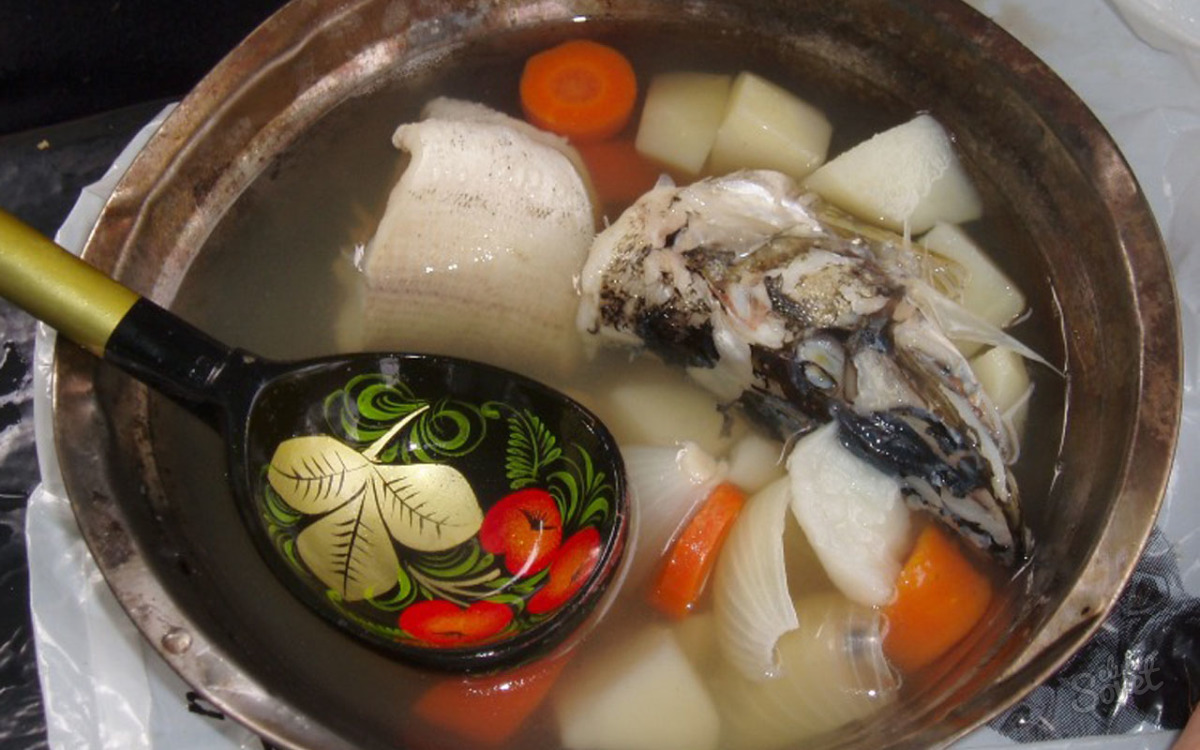
Our tips will help you get a beautiful clear broth. If it still comes out a bit cloudy, don’t worry. This does not affect the taste and quality of the finished dish.


